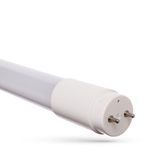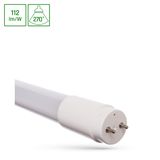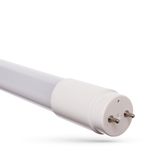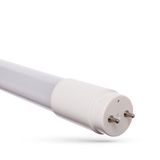Spectrum LED Tubes












spectrum led tubes portfolio and construction
This family covers retrofit formats for common linear lengths—600/1200/1500 mm—with G13 (T8) and G5 (T5) caps. Bodies are glass with shatter-safe film or co-extruded PC/aluminium for light, rigid installs. Typical wattage nodes: 8–10 W (600 mm), 14–16 W (1200 mm), 22–24 W (1500 mm). Output spans ~1 000–3 200 lm depending on optic and CCT. Beam patterns are 160–320°; directional types drive desk planes efficiently in open louvres, while wide beams suit opal channels. Standard colour packs 3000 K/4000 K/6500 K, CRI ≥80 with CRI 90 options for retail and education.
spectrum t8 led tubes series map
Retrofit T8 lines split into three working groups.
- Mains-voltage, single-ended: internal driver on 220–240 V; line/neutral on one cap for fast rewires.
- EM-compatible: drop-in on magnetic ballasts using a supplied LED starter; keeps legacy wiring and speeds rollouts.
- Bypass “UL-Type B” style: both ends live/neutral for redundancy on long runs; used when ballasts are removed during refurbishment.
Professional bins land at PF ≥0.90, THD ≤15 % (often ≤10 %), surge 1–2 kV L-L. Operating window −20…+45 °C; storage −30…+80 °C.
Performance, safety, and standards that matter
- Lamp safety/retrofit: EN 62776 (double-capped LED lamps), IEC/EN 62560 (self-ballasted), photobiological EN 62471 RG0/RG1.
- Drivers: IEC/EN 61347-1/-2-13 and IEC 62384; mains quality EN 61000-3-2/-3-3; EMC EN 55015/EN 61547.
- Life data: sources qualified to LM-80 with TM-21 projections; expect L80 50–60 kh at Ta 25 °C on glass-body pro lines, 30–40 kh on value PC builds.
- Flicker: pro lots target PstLM ≤ 1.0, SVM ≤ 0.4 on compatible dim/EM gear.
- Thermal: keep Tc < 85 °C; enclosed channels need airflow slots or de-rated nodes.
Ballast logic: HF-electronic fluorescent gear is generally not supported—either select EM-compatible SKUs with LED starter or rewire to mains.
spectrum t5 led lighting options
T5 retrofits arrive as HE (14/21/28/35 W equivalents) and HO (24/39/54/80 W equivalents). Because fluorescent T5 optics are tighter, choose wide-beam lamps (≥300°) in parabolic bodies to avoid scallop. Many installs remove the HF ballast and feed 230 V direct; where wiring access is limited, use EM-compatible T5 with a dedicated starter and confirm inrush on shared channels.
Optics, colour quality, and glass choices
Clear glass with internal scattering film maximises lumen retention and keeps straight light lines in louvres. Coated opal sleeves soften luminance for direct-view channels. CRI 90 variants (R9 > 50 on select bins) hold wood and food tones in canteens and retail. CCT drift holds within ≤3 SDCM across batches on project-grade lots—worth calling out when rows span multiple rooms.
Controls, wiring, and installation notes
Dimming is driver-dependent: most retrofits are fixed-output; for dimmable rows, select companion drivers in the body or re-engineer the fitting to LED geartrays. Re-label luminaire internals after bypass (schematic + voltage) per EN 60598 practice. For EM conversions, confirm changeover with local inverter kits; maintained-mode lumens are typically 10–20 % of nominal—size spacing accordingly. Polarised G13 adapters and keyed starters reduce wiring errors during mass rollouts.
spectrum led tube fixtures families
Where a clean-sheet approach is allowed, factory-built battens and channels with integrated trays outperform retrofits: better thermal paths, sealed optics (IP40–IP44 interiors), and cable space for through-wiring and emergency packs. Linear bodies offer opal, micro-prismatic, or batwing films; UGR ≤ 19 is achievable in standard grid layouts. Through-wire kits preserve DALI/1–10 V buses across runs; IK07/IK08 fronts survive late-stage site traffic.
Applications and pairing inside the catalog
Office grids move to 4000 K CRI 80/90 with directional beams to lift utilisation factor. Schools prefer toughened glass bodies that resist bowing in long frames. Retail back-of-house standardises 1200 mm nodes for van-stock simplicity. Cold rooms select glass lamps for UV/temperature stability. For aesthetic zones, combine channels with pendants from the same brand; the result is uniform finishes and shared accessories (roses, grips, glands).
Selection checklist for engineers and buyers
- Retrofit mode: EM-compatible with LED starter vs mains-wired bypass; document the choice on drawings.
- Length/output: pick lm target at maintained Ta; 1200 mm ~1.8–2.2 klm is the sweet spot for 500 lx desk plans.
- Colour: 3000 K hospitality, 4000 K office/healthcare, 6500 K inspection; set CRI per area.
- Electrical: PF/THD limits for your panel, surge level, inrush/channel load; SPD upstream near motors.
- Thermal & IP: enclosed channels → de-rate or swap to fixtures; corridors may need IP40 fronts.
- Labelling: update gear labels post-rewire; include circuit and emergency notes in the tray.
Concise procurement notes
Quote by length, wattage, lumen, CCT, CRI, beam, cap, retrofit mode, and surge level. For continuous runs, request LDT/IES plus Tc diagrams. Order end-caps, diffusers, and EM kits with the same pick list to land kitted cartons.